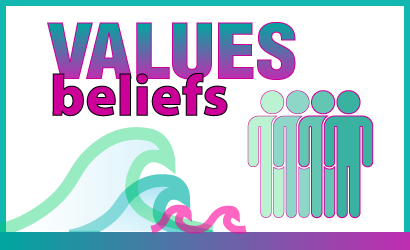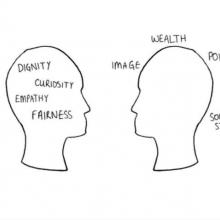

In the context of evidence uptake and sustainability, another key characteristic of social movement action is the presence of intrinsically motivated change agents who are committed to the shared concern or strongly desired change and are ready to take action. In this section, you will learn more about the central role of intrinsic motivation for change agents engaged in social movements and some techniques to inspire this type of motivation in others.
What is the key characteristic
"Intrinsic motivation"?
Motivation explains the reasons behind someone’s actions or behaviours. It can be internal (coming from within) or external (coming from outside factors.)
When internal or intrinsic motivation is activated
- individuals take action because of "free choice" or autonomy; they thrive on the experiences associated with getting involved, and building and expanding personal capacities;
- individuals are "moved" by something (e.g., an issue, concern, or cause) and voluntarily find ways to take action; and
- individuals set goals for themselves that reflect their values (versus an external source) and in doing so, also support their psychological needs of autonomy (i.e., having choice and control in what we do), mastery (i.e., the drive to build competence and self-improvement) and create connections (i.e., having purpose and relationships or social ties with others who share similar goals).
SOURCES: Ben-Hur & Kinley, 2016; Ryan & Deci, 2000.
Intrinsic motivation can be driven also by a yearning to change issues in context – small or big – for the better through individual and collective action that engages people creating emotional bonding and collective identity (Serna Restrepo, et al, 2018). Examples of expressions of intrinsically motivated individuals regarding their work can include deriving pleasure from learning new things, experiencing satisfaction with taking on interesting challenges or feeling satisfied after accomplishing difficult tasks (Tremblay et al., 2009).
Remember: Intrinsically motivated individuals engage with a change initiative because they want to and because they care about the issue.
Extrinsic motivation, in contrast, relies upon the use of extraneous or external incentives or rewards, prodding or pressure from others, or fears of punishment or loss for action or a change in behaviours. Extrinsic motivation is tied to ego and a need to feel significant or important (Ryan & Deci, 2000). Examples of expressions of extrinsically motivated individuals regarding their work can include that it provides an income, a means to earn money, or a source of security or status (Tremblay et al., 2009).
Key differences between intrinsic and extrinsic motivation are captured in the image below.

In addition to extrinsic and intrinsic motivation, there is a state called amotivation which is ranked at the lowest end of the motivation continuum. Individuals who are amotivated either lack intention to take action or act passively. Examples of expressions of amotivation in the context of work can include lacking a rationale for choosing a type of work, feeling that the working conditions are unrealistic or that too much is expected of the workers (Tremblay et al., 2009).
“To be motivated is to be moved to do something.”
(Ryan & Deci, 2000, p. 54)
Why is the key characteristic ‘Intrinsic motivation’ important?
By using sources of intrinsic motivation, individuals are more likely to engage as change agents and/or members of a change team because they personally value the shared concern or desired change and want to address it. The experiences of being a part of a change are seen as meaningful, with a sense of responsibility and pride in the results achieved.
When individuals have the mindset of choosing to engage in change, they act from a place of choice (or autonomy) and emotional power (or individual agency) and are committed to taking on challenges. Intrinsic motivation creates opportunities for change to be realized and goals achieved. This is in part because it sparks creativity in which individuals develop new ideas and solutions. In contrast, a mindset of having to participate in change means that individual choice has been lost and the person feels powerless as they act in a position of compliance. This results often in limited participation as defined by others.
SOURCE: Hilton & Anderson, 2019.
